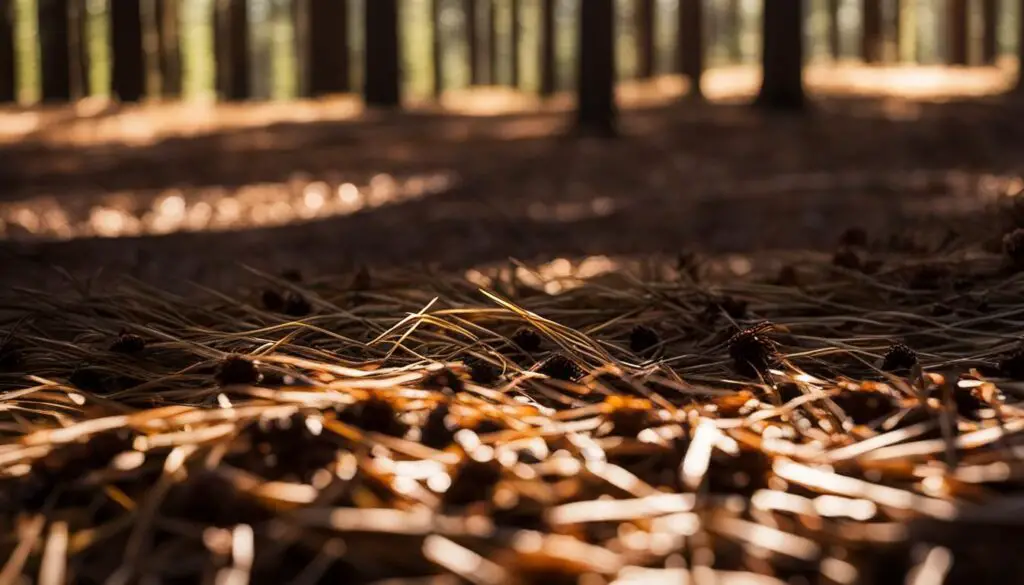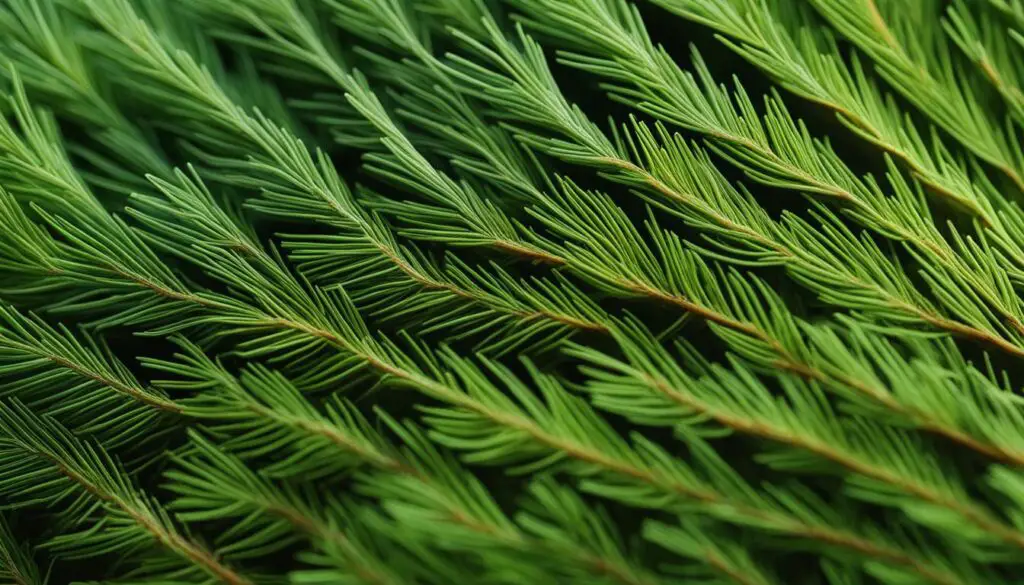Have you ever wondered why pine trees have needles instead of regular leaves like other trees? Well, you’re not alone! Pine trees, like other evergreen and coniferous trees, possess needle-like leaves for a variety of fascinating reasons.
One of the main advantages of pine needles is their unique ability to repel water. Unlike broad leaves that can become waterlogged, the needle shape and structure of pine needles help to deflect raindrops. This enables the tree to shed water effectively, preventing water pooling that can block pores and hinder photosynthesis.
Researchers have discovered that the ridge-shaped profile of pine needles is particularly effective at splitting and dispersing raindrops. This remarkable water-repelling adaptation is especially crucial for pine trees that thrive in rainy environments. In fact, the water-repelling characteristic of pine needles has the potential to revolutionize the design of waterproof fabrics!
Key Takeaways:
- Pine trees have needle-like leaves to repel water and prevent waterlogging.
- The ridge-shaped profile of pine needles helps to split and disperse raindrops.
- The water-repelling characteristic of pine needles has the potential to inspire waterproof fabric design.
The Impact of Pine Needle Carpet on Undergrowth
The presence of a thick layer of fallen pine needles, also known as a needle carpet, has a significant impact on the ability of other plants to grow beneath pine trees. The adaptation of pine trees to shed their needles creates a unique ecosystem that affects the characteristics, anatomy, and evolution of both the pine trees and the undergrowth.
When pine needles cover the ground, they act as a natural mulch, providing several benefits for the soil and undergrowth. The needle carpet helps to conserve soil moisture by reducing evaporation and protecting the soil from direct sunlight. This moisture conservation is crucial, especially in dry or arid environments.
Additionally, the needle carpet inhibits weed growth by blocking sunlight from reaching weed seeds. This creates a more favorable environment for desirable plant species to thrive without competition from unwanted vegetation.
However, the decomposition of pine needles also has unintended consequences for undergrowth. As the needles break down, they release organic acids that lower the pH level of the soil, making it more acidic. This acidic environment poses a challenge for many plant species that prefer neutral or slightly acidic soil conditions.
The acidity of the soil can lead to nutrient imbalances, hindering the establishment and growth of underplanted species. This adaptation of pine trees to create an acidic environment beneath them has shaped the evolution and characteristics of plant species that can tolerate or thrive in these conditions.
Furthermore, pine trees employ chemical warfare through the release of allelopathic chemicals from their needles and roots. These chemicals inhibit the growth of other plants and contribute to the barrenness often observed beneath pine trees.
Despite the challenges posed by the needle carpet and the acidity of pine needles, there are strategies for cultivating undergrowth under pine trees. By carefully selecting plant species that are tolerant of acidic conditions and shade, such as certain ferns and shade-loving perennials, it is possible to create a vibrant and diverse ecosystem beneath the canopy of pine trees.
“The needle carpet acts as a natural mulch, conserving soil moisture and inhibiting weed growth by blocking sunlight.”
The impact of the needle carpet on undergrowth highlights the intricate relationship between pine trees and the plants that grow beneath them. The adaptation of pine trees to shed their needles and create an acidic environment has influenced the evolution of underplanted species and shaped the characteristics and anatomy of both the pine trees and the undergrowth.
The Microclimate Beneath Pine Trees
The area beneath pine trees creates a unique microclimate that presents challenges for undergrowth. The dense shade cast by the evergreen foliage reduces the amount of sunlight that reaches the ground, hampering photosynthesis and creating cooler, moister conditions. The competition for resources, including nutrients and water, is fierce in this shaded microclimate.
However, certain plant species, such as ferns and mosses, have adapted to thrive in these conditions and can make use of the limited resources available.

Strategies for Cultivating Undergrowth under Pine Trees
Cultivating greenery under the canopy of pine trees requires careful selection of plant species and implementation of suitable strategies. By following these underplanting strategies and considering the specific needs of the plants, it is possible to create a thriving ecosystem beneath pine trees.
Choosing Shade-Tolerant Species
One of the key considerations when planting under pine trees is selecting shade-tolerant species. These plants are adapted to thrive in low-light conditions and can withstand the limited sunlight that penetrates through the dense pine foliage. Hostas and ferns are excellent choices, as they are known for their shade tolerance and ability to add texture and variety to the underplanting area.
Opting for Acid-Loving Plants
Pine needles have natural acidity, creating an environment with low soil pH. To counteract this acidity, it is essential to choose acid-loving plants that can thrive in such conditions. Rhododendrons and azaleas are popular choices, known for their vibrant flowers and ability to tolerate acidic soils. These plants will not only adapt well to the pH levels under pine trees but also add color and visual appeal to the underplanting area.
Amending the Soil
To create a favorable environment for underplanted species, it may be necessary to amend the soil. Adding lime or other alkaline materials can help neutralize the acidity caused by the pine needles. Testing the soil and consulting with a garden specialist can provide insight into the appropriate amendments needed for the specific pH requirements of the chosen plants.
Regular Maintenance
Establishing and maintaining underplanted species under pine trees requires regular care and attention. Watering the plants regularly helps ensure they have adequate moisture, as the dense canopy of pine trees can limit rainfall reaching the ground. Weeding is also crucial to prevent weed competition and create optimal growing conditions for the underplanting species. Applying a layer of mulch around the plants helps conserve moisture, regulate soil temperature, and inhibit weed growth.
“Planting under pine trees requires careful consideration of shade tolerance, soil acidity, and regular maintenance. By selecting the right species, amending the soil, and providing proper care, it is possible to create a lush and vibrant undergrowth beneath these majestic trees.”
Remember, when introducing new plants, it’s important to be mindful of the existing root system of the pine tree to avoid disturbing its stability and nutrient absorption. With the right underplanting strategies, you can transform the barren ground beneath pine trees into a beautiful and thriving garden ecosystem.
Unveiling the Secrets of Stomata on Pine Needles
Stomata are microscopic pores found on the surface of pine needles, playing a crucial role in the tree’s survival. These pores regulate gas exchange, allowing for the uptake of carbon dioxide and the release of oxygen during photosynthesis. Stomata also play a vital role in transpiration, the process by which plants release water vapor and maintain the water cycle.
Pine needles have stomata on both the upper and lower surfaces, with varying densities. The specific distribution of stomata is influenced by the length and thickness of the needles, as well as their evolutionary adaptation to different environmental conditions.

| Pine Needle Type | Stomata Density (per mm2) |
|---|---|
| Short Needles | 200 |
| Long Needles | 100 |
The Role of Stomata Distribution
The distribution pattern of stomata on pine needles is not uniform. Short needles tend to have a higher stomata density compared to long needles. This difference in stomata distribution is a result of the adaptation of pine trees to different environments. Short needles with higher stomata density are more efficient in gas exchange, enabling the tree to thrive in regions with limited access to carbon dioxide. On the other hand, long needles with lower stomata density are better suited for environments with higher levels of carbon dioxide and increased water conservation.
“The distribution of stomata on pine needles is an evolutionary marvel, enabling these trees to maximize their photosynthetic capabilities and adapt to various ecological niches.” – Dr. Emily Thompson, Botanist
Understanding the significance of stomata distribution on pine needles provides valuable insights into the adaptive nature of these evergreen giants. This knowledge can further help scientists and environmentalists explore strategies for sustainable forestry and conservation efforts.
Conclusion
In conclusion, pine trees hold a myriad of secrets and mysteries that contribute to their survival and remarkable adaptations. The presence of needles on pine trees serves various functions, including their unique ability to repel water and the release of allelopathic chemicals that inhibit the growth of other plants. These characteristics, combined with the needle carpet and the acidity created by pine needles, create a challenging environment for undergrowth.
However, by understanding these factors, it is possible to cultivate a thriving ecosystem beneath pine trees. Selecting the right plant species, such as shade-tolerant and acid-loving plants, and implementing suitable strategies like soil amendment and regular maintenance, can transform the barren ground into a vibrant and harmonious garden.
The mysteries of pine trees and their adaptations are a testament to nature’s resilience and beauty. Exploring the secrets of pine trees not only deepens our understanding of their survival strategies but also highlights the intricate balance within ecosystems. Let us continue to marvel at the wonders of pine trees and cherish the delicate interplay between nature and its inhabitants.
FAQ
Why do pine trees have needles?
Pine trees have needles for several reasons, one of which is their remarkable ability to repel water. The needle shape and structure of pine needles help to deflect raindrops, allowing the tree to shed water effectively and preventing water pooling that can block pores and hinder photosynthesis.
What is the impact of pine needle carpet on undergrowth?
The thick layer of fallen pine needles, or needle carpet, inhibits weed growth by blocking sunlight and acts as a natural mulch that conserves soil moisture. However, the acidity of the decomposing pine needles can lower the pH level of the soil, making it more challenging for many plant species to establish themselves. Pine trees also release allelopathic chemicals from their needles and roots, further inhibiting the growth of other plants.
What is the microclimate beneath pine trees like?
The area beneath pine trees creates a unique microclimate characterized by dense shade, reduced sunlight, and cooler, moister conditions. This microclimate poses challenges for undergrowth due to competition for limited resources such as nutrients and water. Certain plant species, such as ferns and mosses, have adapted to thrive in these conditions.
What are some strategies for cultivating undergrowth under pine trees?
To cultivate undergrowth under pine trees, it is essential to choose shade-tolerant plant species such as hostas and ferns and acid-loving plants like rhododendrons and azaleas. Amending the soil to counteract the acidity created by pine needles can also be beneficial. Regular maintenance, including watering, weeding, and mulching, helps create a nurturing environment for underplanted species.
What is the significance of stomata on pine needles?
Stomata are microscopic pores found on the surface of pine needles that regulate gas exchange during photosynthesis and transpiration. They allow for the uptake of carbon dioxide and release of oxygen and water vapor. Pine needles have stomata on both the upper and lower surfaces, with varying densities influenced by their length, thickness, and adaptation to different environmental conditions.
What are some secrets of pine trees and their adaptations?
The presence of needles on pine trees serves multiple purposes, such as their water-repelling ability and the release of allelopathic chemicals. The needle carpet and the acidity of pine needles create a challenging environment for undergrowth. However, understanding these factors allows for the implementation of strategies to cultivate a thriving ecosystem beneath pine trees.

